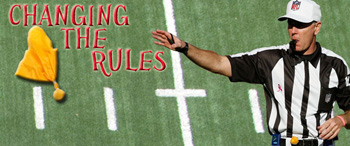Changing the Rules archived
Each Sunday during the NFL season we examine one of the league rules that shape the game as we know it.
Week 8
The Goal Post
Oct. 30, 2011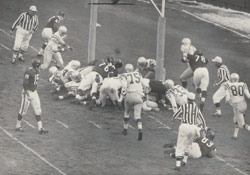 Former New Orleans Saints kicker Tom Dempsey's National Football League record 63-yard field goal in 1970 against the Detroit Lions may not have even been attempted had today's rules applied. That's because from where he kicked, the attempt would have actually have been from 73 yards out. Conversely, the league's other record holders, Jason Elam of the Denver Broncos and Sebastian Janikowski of the Oakland Raiders, would have only been lined up for a 53-yarder back in 1970. That's because the size, shape and placement of the goalposts on the field have changed several times since the NFL was founded in 1920.
Former New Orleans Saints kicker Tom Dempsey's National Football League record 63-yard field goal in 1970 against the Detroit Lions may not have even been attempted had today's rules applied. That's because from where he kicked, the attempt would have actually have been from 73 yards out. Conversely, the league's other record holders, Jason Elam of the Denver Broncos and Sebastian Janikowski of the Oakland Raiders, would have only been lined up for a 53-yarder back in 1970. That's because the size, shape and placement of the goalposts on the field have changed several times since the NFL was founded in 1920.In the league's first year the goal posts were located on the goal line. This changed in 1927 when the NCAA moved them back to the end line (in those days the NFL followed the college rule book so the league quickly followed suit). This however resulted in a reduction of field goals and an increase in tie games. The NFL finally created their own rule book in 1933 and moved the goal posts back to the goal line. Not surprisingly, field goals increased by two-fold and the number of tie games took a downturn.
Not much changed for the next 33 years until 1966 when a resolution was adopted by the NFL owners that required the goal posts to be offset from the goal line and should extend 20 feet in the air. The color of each goal post was also mandated to be bright gold. The next year the league made a decision to require a "sling-shot" type post, eliminating the two-post versions in the end zone which had become more and more of a safety concern.
Finally in 1974 the league pushed the goalposts back to the end line. The change was made mostly to encourage offenses to score touchdowns rather than field goals. The three-pointer had become an increasingly common occurrence by 1973. The move achieved in the league's desired effect, field goals dropped from a total of 543 successful conversions off of 861 attempts in 1973 to 335 field goals made on 553 attempts the following year.
Here's the official account of the ruling on goal posts today.
2011 NFL Rule Book Excerpt
Rule 1, Section 3 - Goal
Crossbar
In the plane of each end line there shall be a centrally placed horizontal Crossbar 18 feet, 6 inches in length, the top face of which is 10 feet above
the ground. The goal is the vertical plane extending indefinitely above the crossbar and between the lines indicated by the outer edges of the goal
posts.
Goal Posts
All goal posts will be the single-standard type, offset from the end line and bright gold in color. The uprights will extend 30 feet above the crossbar
and will be no less than 3 inches and no more than 4 inches in diameter. An orange-colored ribbon 4 inches by 42 inches is to be attached to the
top of each post.
Note: Goal posts must be padded in a manner prescribed by the League.
Week 7
Ball Management
Oct. 23, 2011
Pro football is a tough sport not only on the players but the football too. As such, a steady supply of league-approved balls is needed in every game to make sure the match-up is played on the highest level possible. Over the years there have been many alterations to the rule book concerning the quantity and types of footballs that must be made available for an NFL game. In fact, the most recent change occurred this year. Here, however, are some of the more noteworthy rule changes.
It was not until 1942 that the NFL first documented in their rule book a required number of footballs for each game.
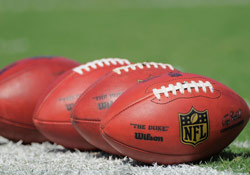 1942 NFL Rule Book excerpt
1942 NFL Rule Book excerpt
Rule 2 – Ball
Supplemental Notes
A League rule requires the home team to have one dozen balls available for the game.
The number of balls provided by the home club remained the same for 34 years until 1976.
1976 NFL Rule Book excerpt
Rule 2 – Ball
Ball Supply
The home club shall have 24 balls available for testing with a pressure gauge by the Referee one hour prior to the starting time of the game to meet
with league requirements.
A pump is to be furnished by the home club, and balls shall remain with and be returned to the ball attendant prior to the start of the game by the
Referee.
In the event a home team ball does not conform to the specifications, or its supply is exhausted, the Referee shall secure a proper ball from visitors
and, failing that, use the best available ball. Any such circumstances must be reported to Commissioner.
In case of rain or a wet, muddy, or slippery field, a playable ball shall be used at the request of the offensive team captain. The watch shall not stop
for such action (unless undue delay occurs.)
NOTE: It is the responsibility of the home team to furnish playable balls at all time by attendants from either side of the playing field.
The football allowance increased again in 1996 to 36. In 1999 however the NFL tabbed 12 of those balls as "k-balls" to be used in the kicking game only. This was done in effort to prevent balls from being doctored by players. For years stories had circulated about how footballs were placed in ovens or clothes dryers to mellow the leather.
1999 NFL Rule Book excerpt
Rule 2 – The Ball
Ball Supply
The home club shall have 24 balls available (domed stadium or outdoor stadium) for testing with a pressure gauge by the Referee two hours prior
to the starting time of the game to meet with league requirements. Twelve (12) new footballs, sealed in a special box and shipped by the
manufacturer, will be opened in the officials' locker room two hours prior to the starting time of the game. These balls are to be specially marked by
the Referee and used exclusively for the kicking game.
Week 6
Sportsmanship
Oct. 16, 2011
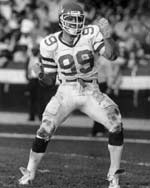 The game of professional football is an emotional one. As such when a team or player is successful on the field sometimes those emotions motivate them to celebrate. That is not always a bad thing unless it is taken to an extreme point.
The game of professional football is an emotional one. As such when a team or player is successful on the field sometimes those emotions motivate them to celebrate. That is not always a bad thing unless it is taken to an extreme point.
Excessive celebrations were starting to take on a life of their own in the early 1980s. The NFL interpreted these celebratory antics as a clear lack of sportsmanship. Usually, and understandably so, the opposing teams took great offense to these celebrations. Some cases resulted in on-field altercations. Two of the more well-known orchestrated celebrations during that time were the Washington Redskins' "Fun Bunch" and the "Sack Dance" by New York Jets defensive end Mark Gastineau.
The "Fun Bunch" comprised mostly of Redskins wide receivers huddled in the end zone after a touchdown and then leaped together as a unit for a collective "high-five." Gastineau's sack dance was a prolonged, seizure-like jig that was initiated every time he dropped a quarterback for a loss. This definitely was not a liked by the opposing team and sometimes even by Gastineau's own teammates.
T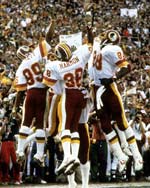 he NFL put a stop to these colorful antics when a rule was passed by the NFL owners in March 1984. Gastineau may have been upset about the rule change, but he certainly could not argue that it affected his game. He went on to register a then-NFL record 22 sacks that season.
he NFL put a stop to these colorful antics when a rule was passed by the NFL owners in March 1984. Gastineau may have been upset about the rule change, but he certainly could not argue that it affected his game. He went on to register a then-NFL record 22 sacks that season.
1984 NFL Rule Book excerpt
Rule 12, Section 2 Personal Fouls; Article 14
There shall be no unsportsmanlike conduct. This applies to any act which is contrary to the generally understood
principals of sportsmanship. Such acts specifically include, among others:
(c) Any prolonged, excessive, or premeditated celebration by individual players or groups of players will be
construed as unsportsmanlike conduct.
Note: Spontaneous expressions of exuberance will be permitted.
Week 5
Stickum
Oct. 9, 2011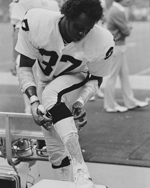 Players in the National Football League will use virtually anything possible to gain an advantage on the football field. One item that saw heavy use in the 1970s and early '80s was "Stickum." Sold under the name of Hold-Tite or Firm Grip, the sticky substance had been used by players for many seasons to help with their grip on the football. Part of the reason it was finally outlawed was because some players took use of the substance to extreme levels.
Players in the National Football League will use virtually anything possible to gain an advantage on the football field. One item that saw heavy use in the 1970s and early '80s was "Stickum." Sold under the name of Hold-Tite or Firm Grip, the sticky substance had been used by players for many seasons to help with their grip on the football. Part of the reason it was finally outlawed was because some players took use of the substance to extreme levels.Fred Biletnikoff, the Pro Football Hall of Fame receiver for the Oakland Raiders, was well known for his great hands. He also was remembered for his excessive use of the "Stickum," as his trademarked look included the substance being smeared all over his socks (see photo below). This allowed him to easily apply the "stickum" during games.
There was no guarantee however that the adhesive would help with catching a ball. Biletnikoff's teammate cornerback Lester Hayes also used the substance liberally. When it was finally banned in March 1981 Hayes took the change in stride while revealing why he liked using so much of the sticky stuff.
"It will have no effect on my game," commented the All-Pro player. "I still dropped the ball even when I used it. It was more of a psychological thing. The opposing players hate
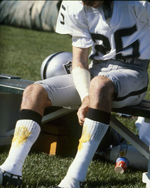 d getting stickum all over them. I loved getting it all over their faces."
d getting stickum all over them. I loved getting it all over their faces."
Therein lied one of the main reasons why "Stickum" was forbidden, it was a mess to clean. Equipment managers despised trying to remove the adhesive from towels and uniforms. It also gummed up the footballs. A special solvent had to be used to remove the gunk which made the surface of the ball slippery.
1981 NFL Rule Book Excerpt
Rule 5, Section 3, Article 1- Equipment
No player shall wear equipment which in the opinion of the officials endangers other players. Types of
equipment, materials, or use of substances which are considered to be illegal include the following:
(k) Use of adhesive or slippery substances on the body, equipment, or uniform of any player.
Archived "Changing the Rules"
Weeks 1-4
Giving Back
Hall of Famers are making news off the field.


